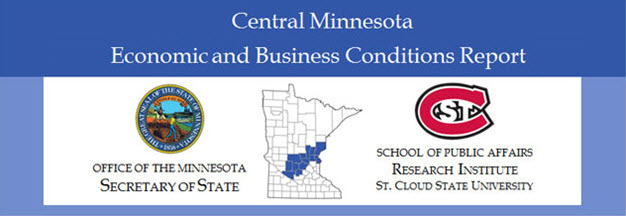Document Type
Research Study
Publication Date
3-2016
Financial Year
2015
Abstract
Slower economic growth in the Central Minnesota planning area is expected to persist over the next several months according to predictions of the Central Minnesota Index of Leading Economic Indicators (LEI). For the second consecutive quarter, the leading index fell in the most recent period, with three components becoming negative. Weakness in a general measure of statewide business conditions and an increase in seasonally adjusted initial jobless claims in Central Minnesota helped drag the LEI lower in the fourth quarter. Also contributing to slower growth was a fall in the number of St. Cloud area residential building permits.
Increased new filings of incorporation and higher national durable goods orders helped lift the index. There were 1,329 new business filings with the Office of the Minnesota Secretary of State in Central Minnesota in the fourth quarter of 2015 — representing an 11.5 percent increase from one year ago. There were 177 new regional business incorporations in the fourth quarter, a 14.9 percent increase from year ago levels. New limited liability company (LLC) filings in Central Minnesota increased 5.1 percent relative to the fourth quarter of 2014—rising to 723 in this year’s fourth quarter. New assumed names totaled 384 over the recent quarter—a rise of 25.5 percent compared to the same period in 2014. There were 45 new filings for Central Minnesota non-profits in the fourth quarter—one more filing than one year ago.
Central Minnesota employment was 2.5 percent higher in December 2015 than it was one year earlier. Compared to one year ago, 9,042 more residents of Central Minnesota now have jobs. The December regional unemployment rate was unchanged from one year ago at 4.2 percent. Initial claims for unemployment insurance were 1.5 percent lower in December than they were one year earlier. The Central Minnesota labor force continues to grow (rising 3.3 percent over the past year) and average weekly wages rose to $740 in this year’s second quarter—a 4.1 percent increase from the same period in 2014.
Economic performance in the St. Cloud area was mixed, with weaker employment and lower new business filings being offset by accelerating wages, a rising work week, lower unemployment rates, fewer jobless claims and more help wanted linage. A recent survey of St. Cloud area business leaders was largely less optimistic than one year earlier. Median home sales prices declined in Central Minnesota’s largest metropolitan area, although a general index suggested the relative cost of living had increased in St. Cloud in 2014.
Recommended Citation
MacDonald, Richard A. and Banaian, King, "Central Minnesota Economic and Business Conditions Report - Fourth Quarter 2015" (2016). Central Minnesota Economic and Business Conditions Report. 8.
https://repository.stcloudstate.edu/qebcr_c_mn/8




